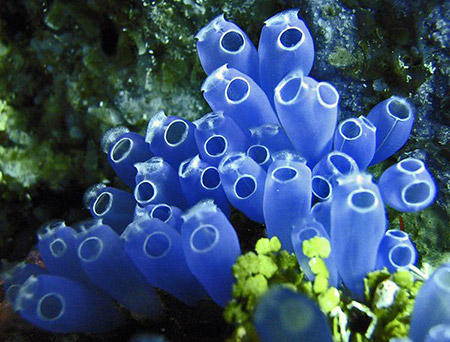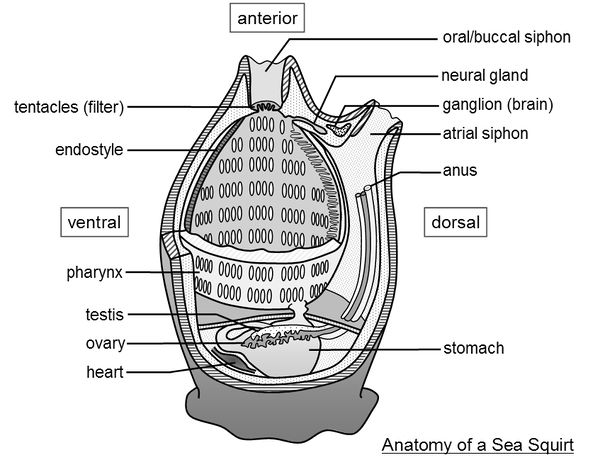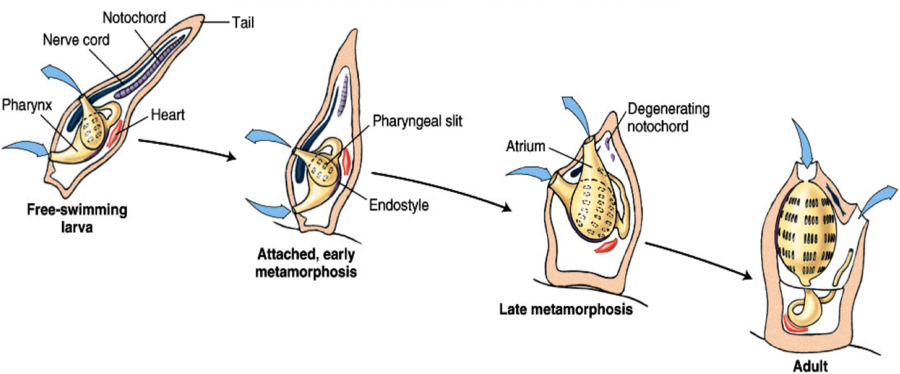Tunicates: Difference between revisions
SSotoDeLeon (talk | contribs) |
SSotoDeLeon (talk | contribs) |
||
| Line 32: | Line 32: | ||
==Reproduction and Life Cycle== | ==Reproduction and Life Cycle== | ||
Tunicates have a brief larval stage in which their main goal is to find a place to live out their adult life. During the larval stage, the tunicates does not have a mouth and doesn't feed. After several days, the larval will attach to a surface using anterior adhesive papillae. As the larva metamorphoses into an adult, the larval tail is resorbed, providing food to the adult tunicate. Free-swimming tunicates metamorphose without attaching to a surface. [http://www.britannica.com/animal/tunicate] | Tunicates have a brief larval stage in which their main goal is to find a place to live out their adult life, this happens in a matter of hours. During the larval stage, the tunicates does not have a mouth and doesn't feed. After several days, the larval will attach to a surface using anterior adhesive papillae. As the larva metamorphoses into an adult, the larval tail is resorbed, providing food to the adult tunicate. Free-swimming tunicates metamorphose without attaching to a surface. [http://www.britannica.com/animal/tunicate] | ||
[[File:metamorphoses.png|900px]] | [[File:metamorphoses.png|900px]] | ||
For the most part, tunicates are hermaphrodites. They can reproduce both sexually and asexually by budding. Tunicates, like most hermaphroditic animals, try to avoid self-fertilizing. Fertilization often occurs in the water surrounding the tunicates, and development occurs in both the surrounding water and in the female tunicates. | For the most part, tunicates are hermaphrodites. They can reproduce both sexually and asexually by budding. Tunicates, like most hermaphroditic animals, try to avoid self-fertilizing. Fertilization often occurs in the water surrounding the tunicates, and development occurs in both the surrounding water and in the female tunicates. | ||
To avoid self-fertilization the tunicate makes sure to not produce a sperm or an egg a the same time. If an egg is produced it stays in the atrium until if can be fertilized. | |||
==Diet and Digestive System== | ==Diet and Digestive System== | ||
Revision as of 12:50, 20 April 2016
Tunicates
Forms of Tunicates
- Solitary Tunicates – some tunicates live alone, not in a colony with other tunicates
- Colonial Tunicates – tunicates are able to bud off individual tunicates and grow colonies. These colonies are similar in resemblance to encrusting marine animals like sponges, but upon closer look they have the same structures as solitary tunicates.
- Drifting Tunicates – Some tunicates never attach to an object or surface, but live as planktonic drifters. They use their siphons for movement.
Comparison of Tunicates and Vertebrates
Tunicates belong to the phylum Urochordata, which is closely related to phylum Chordata that includes all vertebrates.
Tunicates and vertebrates both share a notochord, dorsal hollow, and a nerve cord. These characteristics are only seen in embryonic development of tunicates. Since tunicates are sedentary they lose some parts of their skeletal anatomy. This allows them to attach to their chosen spot, this will then lead them to grow the necessary structures to live an adult life. [1]
Sensory Neural Structures
Anatomy of Tunicates
- Tunic- tissue that can be gelatinous or hard, it provides protection from predators and it also contains cellulose most of the time.
- Heart- pumps blood in a different matter. For a few minutes it will pump in one direction and then pump in reverse for another few minutes.
- Inhalant Siphon- This opening allows the tunicate to feed as well as take in water.
- Exhalant Siphon- the second opening allows the tunicate, after eating and filtering what came in through the first siphon, to expel any waste or water.
- Pharynx- the equivalent of a mouth. The pharynx is inside a larger compartment called the atrium. It is porous to allow water to move out, it also connect the inhalant siphon to the digestive system.
Reproduction and Life Cycle
Tunicates have a brief larval stage in which their main goal is to find a place to live out their adult life, this happens in a matter of hours. During the larval stage, the tunicates does not have a mouth and doesn't feed. After several days, the larval will attach to a surface using anterior adhesive papillae. As the larva metamorphoses into an adult, the larval tail is resorbed, providing food to the adult tunicate. Free-swimming tunicates metamorphose without attaching to a surface. [2]
For the most part, tunicates are hermaphrodites. They can reproduce both sexually and asexually by budding. Tunicates, like most hermaphroditic animals, try to avoid self-fertilizing. Fertilization often occurs in the water surrounding the tunicates, and development occurs in both the surrounding water and in the female tunicates. To avoid self-fertilization the tunicate makes sure to not produce a sperm or an egg a the same time. If an egg is produced it stays in the atrium until if can be fertilized.
Diet and Digestive System
Tunicates mainly eat phytoplankton, zooplankton, detritus and other small organisms in the water, these organisms are filtered through the tunicate. They have cilia in the pharynx and they also produce mucus. Their food gets stuck in the mucus and with the help of beating cilia the mucus moves toward the digestive system. There are also predatory tunicates, which eat small creatures that get pulled through their siphon and get stuck on their mucous.
Distribution and Abundance
Tunicates can be found in ocean waters from polar regions to the tropics. They can be found floating in the ocean water or attached to rocks, docks, ship hulls, and other hard surfaces, usually in the pelagic zone of the water. They can become invasive because colonies can settle on top of other stationary creatures.
Evolution of Tunicates
Ascidiacea- These are referred to as sea squirts. Thaliacea, Larvacea
Fast evolving
Loss of Genes- Some are expressed in similar organisms while others are missing genes.
Larval Stage- Tadpole like stage where are similarities with vertebrates are present.
Works Cited
http://depts.washington.edu/fhlk12/links/StudentProjects/Tun.biology.html
Lemaire P, Piette J. 2015 Tunicates: exploring the sea shores and roaming the open ocean. A tribute to Thomas Huxley. Open Biol. 5: 150053. http://dx.doi.org/10.1098/rsob.150053



